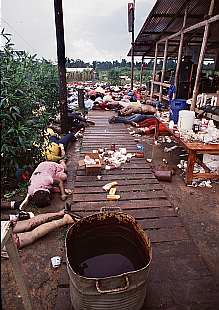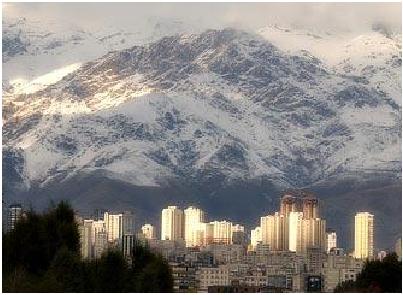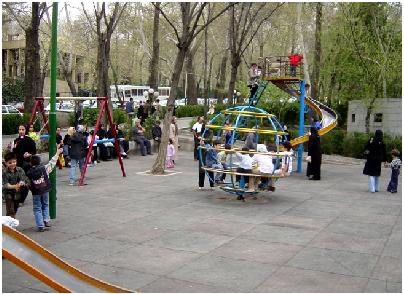Over My Shoulder #32: Mark Kurlansky on the Revolution before the Revolutionary War, from Nonviolence: Twenty-Five Lessons from the History of a Dangerous Idea
Pick a quote of one or more paragraphs from something you’ve read, in print, over the course of the past week. (It should be something you’ve actually read, and not something that you’ve
read
a page of just in order to be able to post your favorite quote.)Avoid commentary above and beyond a couple sentences, more as context-setting or a sort of caption for the text than as a discussion.
Quoting a passage doesn’t entail endorsement of what’s said in it. You may agree or you may not. Whether you do isn’t really the point of the exercise anyway.
Here’s the quote. This is from Mark Kurlansky’s recent book Nonviolence: Twenty-Five Lessons from the History of a Dangerous Idea (2006):
In the years leading up to the American Revolution, the radical revolutionaries, those who wanted to break away from Britain and were prepared to go to war, were a minority, but they were the most vocal and articulate and the best organized faction. Proponents of nonviolence know that it is often not the largest but the best organized and most articulate group that prevails. It is not clear that the decision to go to war against the British was the majority opinion of most of the revolting colonies, but the radicals proceeded and made it a fait accompli.
Another enduring lesson of history is that it is always easier to promote war than peace, easier to end the peace than end the war, because peace is fragile and war is durable. Once the first shots are fired, those who oppose the war are simply branded as traitors. All debate ends once the first shots are fired, so firing shots is always an effective way to end the debate. The silence may not last for long, as the War of 1812, World War I, Vietnam, and Iraq, all unpopular wars, demonstrate, but there is always a moment of enforced silence when debate and criticism are banished and this moment gives the war boosters at least a temporary advantage.
In February 1775 the British sent 240 soldiers to Salem, Massachusetts, to seize ammunition and weapons that the rebels were amassing. Though the nonviolent defense of a weapons cache does not truly qualify as nonviolence, the townspeople’s plan averted violence and prevented the opening of a shooting war. They simply pulled up the drawbridge into town and made the British negotiate entry, which the British did by giving assurances that they would not disturb the town. Apparently the colonists at the drawbridge were less concerned about the fate of the weapons than the principle that the British army had to ask permission before entering their town. According to Hobbesian logic, such happy solutions only put off the inevitable, which came on April 19, when another British column attempted to seize another rebel arms cache, this time in Concord. Whether or not this qualified as what Hobbes termed Natural Law, the reality was that elements among the rebel movement had decided that they wanted a shooting war, and once that kind of decision is made, it is, as a rule, almost impossible to avoid it. American revolutionaries intercepted the British column in Lexington. The rebels only exchanged a few shots and a number of them were killed. Each side claimed the other side had fired first, though all the casualties of this brief first engagement were on the rebel side. The British marched on to the supply depot in Concord. But the shots had been fired, the war begun, and the debate ended.
Curiously, up until those few shots were fired in Lexington, the rebels, even while arguing for war, had been spectacularly successful at what could be considered nonviolent resistance. Both demonstrating and rioting for a wide range of causes were commonplace in eighteenth-century America. One historian, Paul A. Gilje, counted 150 riots and street actions in the thirteen colonies just between 1765 and 1769. Though rules of class conduct were not rigid, generally the upper classes wrote pamphlets and negotiated, while the lower classes took to the street. The lower classes would cart around effigies of officials at their demonstrations before hanging, burning, or beheading them. Even before television there was a belief that effective nonviolence needed to be visual, needed a sense of theater to attract an audience. When the British passed the Stamp Act in 1765, the colonists staged a series of demonstrations throughout the colonies. In Charleston, South Carolina, two thousand demonstrators protested taxes by burning effigies and then staging a mock funeral for the death of
American Liberty.The stamp officials were forced to resign in every colony but Georgia. The demonstrations were accompanied by a boycott of British goods. The result of all this was that within a year the act was repealed. But the following year the British attempted another taxation scheme, the Townsend Acts, which, because they only taxed imports indirectly, the British hoped would be more palatable.The working poor were angry about their economic plight and they were not always nonviolent. They attacked and destroyed homes of officials, and looting was not uncommon. The intellectual leaders, being largely men of property, opposed these acts of destruction and tried to keep the street protests orderly. There was clearly a class division, and the upper-class leaders had to negotiate with the street leaders. The former tried to keep elements that they thought of as rowdy out of demonstrations. They sometimes banned black people from participating in demonstrations, convinced that they were an inherently unruly race.
In 1768 the Massachusetts Assembly dissolved rather than collect the Townsend duties. Not entirely nonviolent, the revolutionaries formed mobs to harass customs officials. On March 5, 1770, boys began throwing snowballs at British troops in Boston. The troops began pushing. Men came to the aid of boys. When one British soldier was struck with a club, he responded by firing into the crowd. Other soldiers also fired and five colonists were killed. When the British soldiers were brought to trial, John Adams, a moderate, defended them and noted in defense of the troops that black people were in the crowd. As a matter of fact, a mulatto man, Crispus Attucks, was among the victims. The British were acquitted.
By 1770 the British recognized the Townsend Acts to be another political and financial disaster and repealed them. But the tax on tea remained. This led to the most famous act of nonviolence in the American colonial period.
The American revolutionaries, in their prewar days, were particularly effective in their use of an important nonviolent tool, the boycott. Women began weaving cloth by hand rather than buy fabric from British mills. Homespun became the fashion. Spinning bees became patriotic gatherings. One result of the tea boycott was that Americans very quickly became coffee drinkers. But there were many debates in Boston on how to take the tea boycott even further. On December 16, 1773, sixty revolutionaries, dressed as Mohawk Indians, boarded three ships in Boston Harbor and dumped 342 chests of tea valued at £10,000 into the sea. This was a perfectly managed act of nonviolent protest. There were no incidents of looting or vandalism. According to legend, one padlock was broken and the revolutionaries replaced it.
Though far less famous today than the Boston Tea Party, the crowning achievement of American colonial civil disobedience, the one that John Adams considered the turning point of the American Revolution, came in 1774, before any shots were fired. The colonies were becoming ungovernable and unprofitable. The British were responding with repression, including the so-called Coercive Acts, which cost them more money and tied up more troops. From the point of view of the rebels, the British response was ideal, as it was mobilizing public opinion against England. One of the new repressive measures enacted by the British Parliament, intended as a response to the Boston Tea Party, was the Massachusetts Government Act passed in the spring of 1774. It removed the right of Massachusetts’ elected representatives to have a say in the appointment of judges. When the new British-appointed Court of Common Pleas for the county of Worcester tried to sit in September, thousands turned out to block them. Of the estimated six thousand, about one thousand were armed. They stopped the court from coming to session and formed a
conventionthat effectively took over, closing courts and freeing prisoners.The weapons, which were not used, were unnecessary, since no armed force opposed them. Everywhere else in Massachusetts where the British tried to open a Court of Common Pleas, they were also stopped by huge crowds, which often had no weapons at all. The crowds were large enough to keep the courts closed, force the judges to resign, and keep the army helplessly at a distance.
The revolution had overthrown the government in Massachusetts without a shot being fired. Why, then, did the rebels turn to arms? Sentiment was already strongly anti-British. John Adams wrote to Jefferson late in his life,
The revolution was in the minds of the people, and in the union of the colonies, both of which were accomplished before the hostilities commenced.So why was the war necessary? Jonathan Schell in The Unconquerable World astutely noted that the participants in other revolutions had reached similar conclusions. The Romantic writer François René de Chateaubriand, who lived through the French Revolution, said almost the exact same thing:The French Revolution was accomplished before it occurred.And Leon Trotsky, one of the authors of the Russian Revolution, wrote,The declaration of October 23 had meant the overthrow of the power before the government itself was overthrown.So if revolutions are accomplished in the minds of the people, why must they be followed by force of arms? Why do almost all political theorists–not only Locke, Hobbes, and Rousseau, but later ones such as Marx and Lenin–insist that a revolution must be an armed movement? If the outbreak of war is inevitable, as seventeenth-century thinkers believed, history teaches the lesson that its inevitability does not rest, as they believed, on natural law, but on individuals incapable of conceiving of another path. Is the source of violence not human nature, as Hobbes contended, but a lack of imagination?
In the case of the American Revolution, could independence have been accomplished without warfare? The British gave up on America even though the Americans had scored very few military victories in the war, because they wanted to get on with other business, including their European wars, and could not afford to tie up military and money in these colonies any longer. But the path of disruption and protest had already been tying up British troops, costing British money, making the colonies unprofitable–the very reasons that Britain later gave up the war and negotiated peace. Colonies were supposed to earn, not cost. It seems quite possible that the British withdrawal could have been achieved by continuing protest and economic sabotage.
–Mark Kurlansky (2006): Nonviolence: Twenty-Five Lessons from the History of a Dangerous Idea. 75–80.



